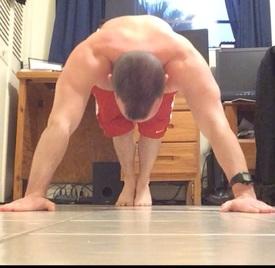Overhead Press, What is a full rep?!
Replies
-
Oh, well, awsome lol thanks for the props. It's kind of arbitrary, but my goal for now is to reach bodyweight or something close to it. It depends on how my bum shoulder feels at that point (left shoulder took a nasty hit back in college, an aluminum light post, involves a bike... like a bicycle... don't ask), but I think I would be happy at that weight. Don't want to push it though, it didn't feel great after yesterday's shoulder day, shoulder is kind of tempermental.
@ Nick, why ohp as assistance for now?0 -
Oh, well, awsome lol thanks for the props. It's kind of arbitrary, but my goal for now is to reach bodyweight or something close to it. It depends on how my bum shoulder feels at that point (left shoulder took a nasty hit back in college, an aluminum light post, involves a bike... like a bicycle... don't ask), but I think I would be happy at that weight. Don't want to push it though, it didn't feel great after yesterday's shoulder day, shoulder is kind of tempermental.
@ Nick, why ohp as assistance for now?
I'm following the Cube method and the workouts are basically like this:
Day 1: Squat (DE, ME, or RE depending on the week)
Day 2: Bench (same as above)
Day 3: Deadlift (same)
Day 4: High-Volume training with a focus on weak-points (Tri's, Bi's, Lats, Calves, Delts, etc)
I'm trying to actually include some heavier OHP work in on Day 4 but I don't always have time for Day 4 and squeeze some of the weak point training into my other 3 days.Don't want to push it though, it didn't feel great after yesterday's shoulder day, shoulder is kind of tempermental.
Get yourself some light bands do something like these: http://www.youtube.com/watch?v=NKBsia-o9N4
http://www.youtube.com/watch?v=NKBsia-o9N4 http://www.youtube.com/watch?v=a8tMmzWuhlU
http://www.youtube.com/watch?v=a8tMmzWuhlU
I also like doing banded Shoulder Separations. At one point last year I thought I was going to need shoulder surgery my shoulder was in so much pain. I found this and started doing them and my shoulder health has greatly improved.0 -
Just sounds like restricted ROM and/or bad form. If the elbows flare out too much, it will strain your shoulders more.0
-
Just sounds like restricted ROM and/or bad form. If the elbows flare out too much, it will strain your shoulders more.
I'll keep this in mind thanks.0 -
Just sounds like restricted ROM and/or bad form. If the elbows flare out too much, it will strain your shoulders more.
I'll keep this in mind thanks.
Try and keep your hand placement just outside of your shoulder too.0 -
Alright so first and foremost, what has helped aleviate a lot of my shoulder issues with the OHP are the following:
1. Remembering to apply equal pressure with both arms in the lift (I'm righty, but I was actually pressing harder with my left)
2. Warming up using DeFranco's "Supple 6" routine. Google it now, thank me later.
Also, I'm pretty much just resting about an inch above my chest, then droping to my chest before pressing up to lockout. In two weeks I'll be doing 135 for the first time, shoulder problems are non existent at the moment, or at least no worse than before.0
This discussion has been closed.
Categories
- All Categories
- 1.4M Health, Wellness and Goals
- 398.1K Introduce Yourself
- 44.7K Getting Started
- 261K Health and Weight Loss
- 176.4K Food and Nutrition
- 47.7K Recipes
- 233K Fitness and Exercise
- 462 Sleep, Mindfulness and Overall Wellness
- 6.5K Goal: Maintaining Weight
- 8.7K Goal: Gaining Weight and Body Building
- 153.5K Motivation and Support
- 8.4K Challenges
- 1.4K Debate Club
- 96.5K Chit-Chat
- 2.6K Fun and Games
- 4.8K MyFitnessPal Information
- 18 News and Announcements
- 21 MyFitnessPal Academy
- 1.5K Feature Suggestions and Ideas
- 3.2K MyFitnessPal Tech Support Questions


